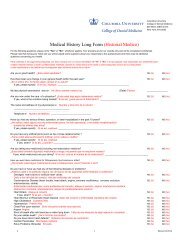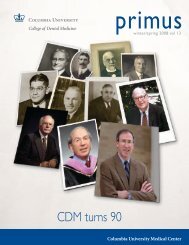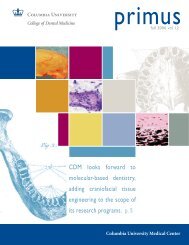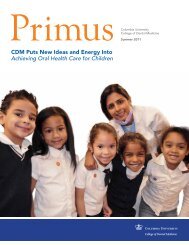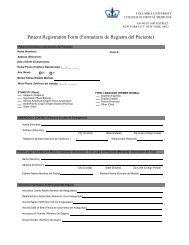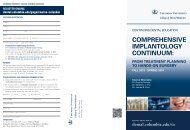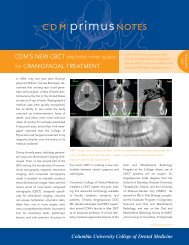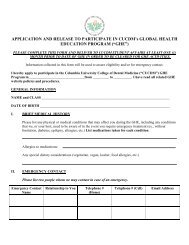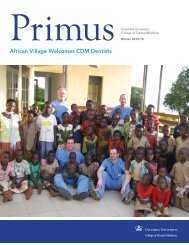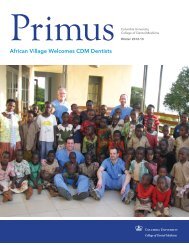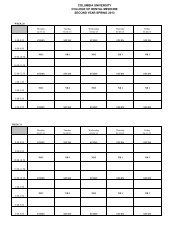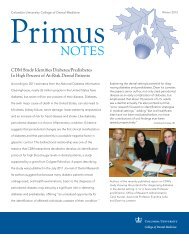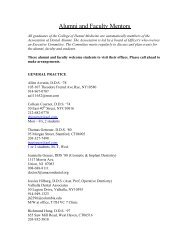Jarvie Journal - College of Dental Medicine - Columbia University
Jarvie Journal - College of Dental Medicine - Columbia University
Jarvie Journal - College of Dental Medicine - Columbia University
Create successful ePaper yourself
Turn your PDF publications into a flip-book with our unique Google optimized e-Paper software.
A Tooth Model Evaluation <strong>of</strong> Human <strong>Dental</strong> Pulp Cell Response to PEGDA Hydrogel<br />
Ashkan Davary 1 , Sagaw Prateepchinda 2 , Gunnar Hasselgren 1* , Helen Lu 2*<br />
1 <strong>College</strong> <strong>of</strong> <strong>Dental</strong> <strong>Medicine</strong>, <strong>Columbia</strong> <strong>University</strong>, New York, NY;<br />
2 Department <strong>of</strong> Biomedical Engineering, <strong>Columbia</strong> <strong>University</strong>, New York, NY; *Faculty Mentor<br />
Introduction: More than 24 million teeth receive root canal treatment each year. Current endodontic treatment replaces vital pulp<br />
tissue with synthetic material. Teeth whose pulp tissue has been removed are more vulnerable to injury, which threatens the longevity<br />
<strong>of</strong> the tooth. Therefore, a treatment which is able to maintain the vitality <strong>of</strong> the pulp or regenerate pulp tissue provides a preferable<br />
alternative to current endodontic treatment. Synthetic biomaterial scaffolds play an essential role in new tissue formation. An<br />
appropriate scaffold for pulp tissue regeneration should support pulp cell viability, proliferation, and matrix synthesis. Polyethylene<br />
glycol diacrylate (PEGDA) hydrogels have been investigated as matrices for engineering various tissues. PEG hydrogels are<br />
synthetic, biocompatible, hydrophilic polymers composed <strong>of</strong> 3D interstitial cross-links. These polymers have the advantage <strong>of</strong> being<br />
injectable, photocrosslinkable, and their mechanical properties can be precisely controlled by altering weight percent, molecular<br />
chain length, and crosslinking density. The current study uses a tooth organ model, which simulates the clinical situation <strong>of</strong> pulp<br />
tissue regeneration, for evaluating PEGDA-based scaffolds as a substrate for supporting human dental pulp cell regeneration.<br />
Objective: To assess the response <strong>of</strong> human dental pulp cells in a PEGDA hydrogel cultured within human teeth. Cell viability,<br />
proliferation, mineralization potential, and collagen deposition were analyzed. We anticipate that a PEGDA- based gel will support<br />
pulp cell viability, proliferation, mineralization potential and collagen deposition.<br />
Methods:<br />
Scaffold Preparation & Cell Culture - Human adult dental pulp cells (P.4, explant culture) from molar teeth were seeded in PEGDA<br />
(10kDa, 4.02% w/v) solution at 4.8 million cells/mL, injected into the pulp chamber <strong>of</strong> sectioned adult molar teeth, photopolymerized<br />
with 0.1% (w/v) Irgacure2959 under UV light (365nm), and maintained in fully supplemented medium with ascorbic<br />
acid. Monolayer cell culture served as control group.<br />
Endpoint Analyses - Samples were analyzed at 7 and 28 days for cell viability (n = 2), cell proliferation (n=6), collagen content<br />
(n=6), alkaline phosphatase (ALP) activity (n=6) and collagen deposition (n=6).<br />
Statistical Analysis - Two-way ANOVA and the Turkey-Kramer post-hoc test were used for all pair-wise comparisons (p



